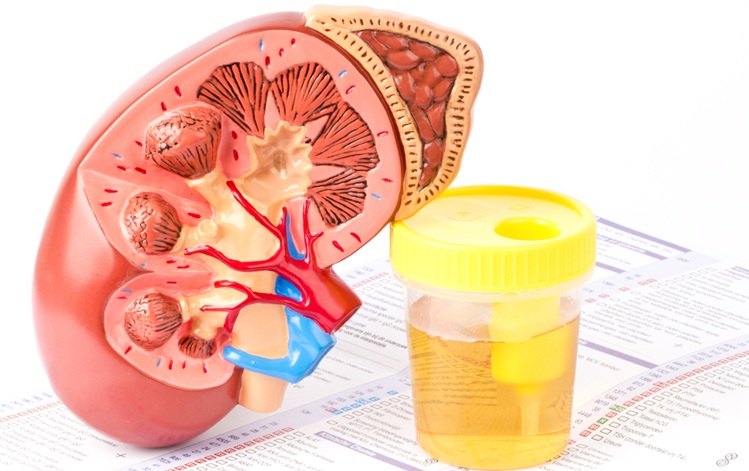Breath Test Determines Severity of Methylmalonic Acidemia Disease
|
By LabMedica International staff writers Posted on 20 Apr 2021 |

Image: The BreathID Exalenz device (Photo courtesy of Meridian Bioscience)
Methylmalonic acidemia is a disorder in which the body cannot break down certain proteins and fats. The result is a buildup of a substance called methylmalonic acid in the blood. This condition is passed down through families and is one of several conditions called an "inborn error of metabolism."
Methylmalonic acidemia affects about 1 in 80,000 newborns and can lead to the buildup of proteins and fats by affecting their metabolism, and cause kidney, liver, and other disease. Methylmalonic acidemia is a genomic disorder that can be caused by mutations in the methylmalonyl-CoA mutase (MMUT) gene.
A large team of medical genomic scientists at the National Human Genome Research Institute (Bethesda, MD, USA) developed a non-invasive test that gauges disease severity by measuring patients' metabolism though the levels of 1-13C-propionate in their breath. The team administered their test to 57 methylmalonic acidemia (MMA) patients and 16 healthy volunteers to find patients with severe subtypes of the disease had low propionate oxidation levels, while those with less severe disease or who had been treated with liver transplants had near-normal propionate oxidation levels.
Isotopomer enrichment (13CO2/12CO2) was measured in exhaled breath after an enteral bolus of sodium-1-13C-propionate, and normalized for CO2 production. 1-13C-propionate oxidation was then correlated with clinical, laboratory, and imaging parameters collected via a dedicated natural history protocol. Breath samples were collected via disposable breath collection kits (EasySampler Breath Test Kit, QuinTron, Santa Maria, CA, USA) prior to isotope administration, and at specified time points over two hours. A second method, utilizing the BreathID Exalenz device (Meridian Bioscience, Cincinnati, OH, USA) was also employed.
The scientists reported that Lower propionate oxidation was observed in patients with the severe mut0 and cblB subtypes of MMA, but was near normal in those with the cblA and mut− forms of the disorder. Liver transplant recipients demonstrated complete restoration of 1-13C-propionate oxidation to control levels. 1-13C-propionate oxidation correlated with cognitive test result, growth indices, bone mineral density, renal function, and serum biomarkers. Test repeatability was robust in controls and in MMA subjects (mean coefficient of variation 6.9% and 12.8%, respectively), despite widely variable serum methylmalonic acid concentrations in the patients.
Charles P. Venditti, MD, PhD, the principal investigator and senior author of the study, said, “Our next goal is to see if this specialized breath test can detect increase in carbon 13 propionate oxidation after gene, mRNA, or genome editing therapies. This way, we can also use this test to measure how effective these treatments are in restoring MMUT function.”
The authors concluded that propionate oxidative capacity, as measured with 1-13C-propionate breath testing, predicts disease severity and clinical outcomes, and could be used to assess the therapeutic effects of liver-targeted genomic therapies for MMA and related disorders of propionate metabolism. The study was published on April 5, 2021 in the journal Genetics in Medicine.
Related Links:
National Human Genome Research Institute
QuinTron
Meridian Bioscience
Methylmalonic acidemia affects about 1 in 80,000 newborns and can lead to the buildup of proteins and fats by affecting their metabolism, and cause kidney, liver, and other disease. Methylmalonic acidemia is a genomic disorder that can be caused by mutations in the methylmalonyl-CoA mutase (MMUT) gene.
A large team of medical genomic scientists at the National Human Genome Research Institute (Bethesda, MD, USA) developed a non-invasive test that gauges disease severity by measuring patients' metabolism though the levels of 1-13C-propionate in their breath. The team administered their test to 57 methylmalonic acidemia (MMA) patients and 16 healthy volunteers to find patients with severe subtypes of the disease had low propionate oxidation levels, while those with less severe disease or who had been treated with liver transplants had near-normal propionate oxidation levels.
Isotopomer enrichment (13CO2/12CO2) was measured in exhaled breath after an enteral bolus of sodium-1-13C-propionate, and normalized for CO2 production. 1-13C-propionate oxidation was then correlated with clinical, laboratory, and imaging parameters collected via a dedicated natural history protocol. Breath samples were collected via disposable breath collection kits (EasySampler Breath Test Kit, QuinTron, Santa Maria, CA, USA) prior to isotope administration, and at specified time points over two hours. A second method, utilizing the BreathID Exalenz device (Meridian Bioscience, Cincinnati, OH, USA) was also employed.
The scientists reported that Lower propionate oxidation was observed in patients with the severe mut0 and cblB subtypes of MMA, but was near normal in those with the cblA and mut− forms of the disorder. Liver transplant recipients demonstrated complete restoration of 1-13C-propionate oxidation to control levels. 1-13C-propionate oxidation correlated with cognitive test result, growth indices, bone mineral density, renal function, and serum biomarkers. Test repeatability was robust in controls and in MMA subjects (mean coefficient of variation 6.9% and 12.8%, respectively), despite widely variable serum methylmalonic acid concentrations in the patients.
Charles P. Venditti, MD, PhD, the principal investigator and senior author of the study, said, “Our next goal is to see if this specialized breath test can detect increase in carbon 13 propionate oxidation after gene, mRNA, or genome editing therapies. This way, we can also use this test to measure how effective these treatments are in restoring MMUT function.”
The authors concluded that propionate oxidative capacity, as measured with 1-13C-propionate breath testing, predicts disease severity and clinical outcomes, and could be used to assess the therapeutic effects of liver-targeted genomic therapies for MMA and related disorders of propionate metabolism. The study was published on April 5, 2021 in the journal Genetics in Medicine.
Related Links:
National Human Genome Research Institute
QuinTron
Meridian Bioscience
Latest Clinical Chem. News
- VOCs Show Promise for Early Multi-Cancer Detection
- Portable Raman Spectroscopy Offers Cost-Effective Kidney Disease Diagnosis at POC
- Gold Nanoparticles to Improve Accuracy of Ovarian Cancer Diagnosis
- Simultaneous Cell Isolation Technology Improves Cancer Diagnostic Accuracy
- Simple Non-Invasive Hair-Based Test Could Speed ALS Diagnosis
- Paper Strip Saliva Test Detects Elevated Uric Acid Levels Without Blood Draws
- Prostate Cancer Markers Based on Chemical Make-Up of Calcifications to Speed Up Detection
- Breath Test Could Help Detect Blood Cancers
- ML-Powered Gas Sensors to Detect Pathogens and AMR at POC
- Saliva-Based Cancer Detection Technology Eliminates Need for Complex Sample Preparation
- Skin Swabs Could Detect Parkinson’s Years Before Symptoms Appear
- New Clinical Chemistry Analyzer Designed to Meet Growing Demands of Modern Labs

- New Reference Measurement Procedure Standardizes Nucleic Acid Amplification Test Results
- Pen-Like Tool Quickly and Non-Invasively Detects Opioids from Skin
- Simple Urine Test Could Detect Multiple Cancers at Early Stage
- Earwax Test Accurately Detects Parkinson’s by Identifying Odor Molecules
Channels
Molecular Diagnostics
view channel
Urine Test Detects Early Stage Pancreatic Cancer
Pancreatic cancer remains among the hardest cancers to detect early. In the UK, around 10,000 people are diagnosed each year, but only 5% survive beyond five years. Late diagnosis is a major factor—more... Read more
Genomic Test Could Reduce Lymph Node Biopsy Surgery in Melanoma Patients
Accurately determining whether melanoma has spread to the lymph nodes is crucial for guiding treatment decisions, yet the standard procedure—sentinel lymph node biopsy—remains invasive, costly, and unnecessary... Read moreHematology
view channel
ADLM’s New Coagulation Testing Guidance to Improve Care for Patients on Blood Thinners
Direct oral anticoagulants (DOACs) are one of the most common types of blood thinners. Patients take them to prevent a host of complications that could arise from blood clotting, including stroke, deep... Read more
Viscoelastic Testing Could Improve Treatment of Maternal Hemorrhage
Postpartum hemorrhage, severe bleeding after childbirth, remains one of the leading causes of maternal mortality worldwide, yet many of these deaths are preventable. Standard care can be hindered by delays... Read more
Pioneering Model Measures Radiation Exposure in Blood for Precise Cancer Treatments
Scientists have long focused on protecting organs near tumors during radiotherapy, but blood — a vital, circulating tissue — has largely been excluded from dose calculations. Each blood cell passing through... Read moreImmunology
view channel
Blood-Based Liquid Biopsy Model Analyzes Immunotherapy Effectiveness
Immunotherapy has revolutionized cancer care by harnessing the immune system to fight tumors, yet predicting who will benefit remains a major challenge. Many patients undergo costly and taxing treatment... Read more
Signature Genes Predict T-Cell Expansion in Cancer Immunotherapy
Modern cancer immunotherapies rely on the ability of CD8⁺ T cells to rapidly multiply within tumors, generating the immune force needed to eliminate cancer cells. However, the biological triggers behind... Read moreMicrobiology
view channel
Fast Noninvasive Bedside Test Uses Sugar Fingerprint to Detect Fungal Infections
Candida bloodstream infections are a growing global health threat, causing an estimated 6 million cases and 3.8 million deaths annually. Hospitals are particularly vulnerable, as weakened patients after... Read more
Rapid Sepsis Diagnostic Device to Enable Personalized Critical Care for ICU Patients
Sepsis is a life-threatening condition that occurs when the body’s response to infection spirals out of control, damaging organs and leading to critical illness. Patients often arrive at intensive care... Read morePathology
view channel
New Molecular Analysis Tool to Improve Disease Diagnosis
Accurately distinguishing between similar biomolecules such as proteins is vital for biomedical research and diagnostics, yet existing analytical tools often fail to detect subtle structural or compositional... Read more
Tears Offer Noninvasive Alternative for Diagnosing Neurodegenerative Diseases
Diagnosing and monitoring eye and neurodegenerative diseases often requires invasive procedures to access ocular fluids. Ocular fluids like aqueous humor and vitreous humor contain valuable molecular information... Read moreTechnology
view channel
Cell-Sorting Device Uses Electromagnetic Levitation to Precisely Direct Cell Movement
Sorting different cell types—such as cancerous versus healthy or live versus dead cells—is a critical task in biology and medicine. However, conventional methods often require labeling, chemical exposure,... Read more
Embedded GPU Platform Enables Rapid Blood Profiling for POC Diagnostics
Blood tests remain a cornerstone of medical diagnostics, but traditional imaging and analysis methods can be slow, costly, and reliant on dyes or contrast agents. Now, scientists have developed a real-time,... Read moreIndustry
view channel
Qiagen Acquires Single-Cell Omics Firm Parse Biosciences
QIAGEN (Venlo, Netherlands) has entered into a definitive agreement to fully acquire Parse Biosciences (Seattle, WA, USA), a provider of scalable, instrument-free solutions for single-cell research.... Read more
Puritan Medical Products Showcasing Innovation at AMP2025 in Boston
Puritan Medical Products (Guilford, ME, USA), the world’s most trusted manufacturer of swabs and specimen collection devices, is set to exhibit at AMP2025 in Boston, Massachusetts, from November 11–15.... Read more
Advanced Instruments Merged Under Nova Biomedical Name
Advanced Instruments (Norwood, MA, USA) and Nova Biomedical (Waltham, MA, USA) are now officially doing business under a single, unified brand. This transformation is expected to deliver greater value... Read more





















